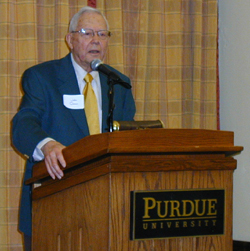Purdue Honors John Osmun at 70th Pest Management Conference
By BRAD HARBISON
PCT Online News
Monday, January 16, 2006
 |
| Purdue Professor Emeritus John Osmun speaks during a special ceremony in his honor at at last week's Purdue Pest Management Conference. |
WEST LAFAYETTE, Ind. - As part of the celebration of the 70th Annual Purdue Pest Management Conference, the university, friends and colleagues recognized John Osmun during a special reception on Jan 11. Osmun is considered one of the most universally respected educators in the pest control industry. Osmun’s career in pest control spans more than 50 years. Prior to arriving at Purdue, Osmun served as chief entomologist with the U.S. Army and a research entomologist with Merck & Co. Osmun joined the Purdue faculty in 1948 as an assistant professor of entomology, where he developed a four-year curriculum in structural pest control.
In the mid-1970s, Osmun left Purdue to become director of EPA’s Operations Division and he later served as a consultant to EPA. He would later return to Purdue. Osmun joined EPA during a time in which the agency’s role was placing more emphasis on setting standards. "I saw it as an opportunity to develop standards for applicators based on education," Osmun said during last week’s reception.
In looking to the pest management industry’s future, Osmun is optimistic. "You have the foundation of professional people working in the field, so I only see the industry getting better," Osmun added.
Tom Turpin, a professor in Purdue’s Department of Entomology, emceed last week’s ceremony. Along with Turpin, Osmun protégés Austin Frishman and Kathy Heinsohn spoke at last week’s ceremony and both noted that one of Osmun’s enduring legacies is the number of Purdue entomology students he has impacted. "John wakes up every day fighting to improve the industry," Frishman said. "When you toss a pebble into a pond, the water ripples out. John’s contributions to the pest management industry continue to ripple out with a very positive effect."
|